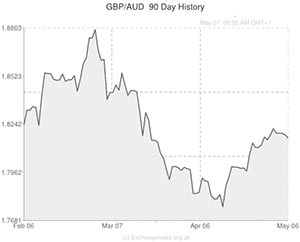
On Tuesday the Pound recovered losses against the Australian Dollar thanks to a surprisingly strong UK services PMI report.
The GBP to AUD pairing had previously declined during Australasian trading in response to the Reserve Bank of Australia’s rate decision.
While the ‘Aussie’ had come under pressure as a result of China’s disappointing manufacturing PMI and below-forecast domestic trade data, the South Pacific currency broadly strengthened after the central bank announcement.
As expected by economists, the RBA opted to leave interest rates at record lows, with the benchmark rate holding at 2.5 per cent.
While the central bank delivered a fairly optimistic policy statement, RBA Governor Glenn Stevens did acknowledge that growth in China (Australia’s main trading partner) ‘slowed a little in early 2014’.
The ‘Aussie’ advanced on peers like the Pound and Euro overnight and strengthened by 0.5 per cent against the US Dollar.
The RBA decision prompted this response from senior economist Craig James; ‘A long period of low, stable interest rates would act as a nice foil to the uncertainty generated by the federal budget. The housing construction boom has potential to be an extended boom given that there is a longer period between the concept and completion of an apartment bloc and the same life cycle of new free-standing house.’
However, in spite of the Australian Dollar’s initial gains, some industry experts believe the commodity-driven currency will return to trading within a narrow range in the days ahead.
According to currency strategist Robert Rennie; ‘The recent weakness in the consumer price index, ongoing softness in bulk commodity prices, risks surrounding the budget and signs of softening in business and consumer confidence is not the recipe we would expect to lead to an Australian Dollar outperformance.’
Although the ‘Aussie’ held gains against peers like the ‘Greenback’ as local trading closed, the GBP/AUD pairing was able to recoup declines during the European session after UK Markit/CIPS services PMI was published.
The services measure advanced from 57.6 in March to 58.7 in April – defying economist’s expectations for a reading of 57.8.
The report showed sharp increases in new business and activity as well as a strong improvement in employment.
Markit economist Chris Williamson said this of the result; ‘The UK economic recovery shows no signs of running out of steam, and growth could even accelerate further in the second quarter. The upturn in service sector growth matches a similar acceleration to a near-record high for manufacturing output, while construction activity also continues to surge higher’.
As this report follows last week’s unexpectedly upbeat UK manufacturing report the Pound was buoyed by the result.
Tomorrow Australia’s AiG performance of construction index and domestic retail sales report, coupled with China’s services PMI, could trigger further Australian Dollar movement.
Investors with an interest in the GBP/AUD pairing will also be looking ahead to Thursday and the Bank of England’s rate decision.
Updated at 10:00 GMT on 07/05/2014
While the AUD/GBP pairing failed to recoup losses, the Australian Dollar achieved a two-week high against its US counterpart during the local session.
However, these gains proved short lived and the ‘Aussie’ went on to broadly soften in response to disappointing domestic retail sales figures.
While a sales increase of 0.4 per cent was expected, retail sales only rose by 0.1 per cent in March, month-on-month.
On the quarter sales were up 1.2 per cent in the first three months of the year, less than the 1.6 per cent gain projected.
Australia’s AiG performance of construction index for April also slid from 46.2 to 45.9, falling further below the 50 mark separating growth from contraction.
The report detailed an increase in home building but a drop in commercial and engineering contracts.
According to an AiG official; ‘The deepening slide in engineering construction is overshadowing the growth in residential building activity and the tentative recovery of commercial construction as seen in the expansion in April of new commercial construction orders.’
However, he added that it is ‘encouraging to see that after experiencing three consecutive months of contraction, the apartment building sub-index has returned to expansionary territory in April. The residential construction sector has a large reach into the broader domestic economy and it will become increasingly important in 2014’.
The Pound’s bullish relationship with the ‘Aussie’ (inspired by yesterday’s impressive UK services data) also persisted as China’s services PMI for April showed weaker-than-forecast expansion.
Although the gauge held above the 50 mark separating growth from contraction, it came in at 51.4 rather than the 51.9 projected.
HSBC economist Hongbin Qu said this of the result; ‘The employment sub-index fell to a seven-month low and is now barely above the 50.0 neutral mark […] Today’s release showed that the service sector is still a relatively resilient part of the economy, but it is not expanding at a fast enough pace to offset the manufacturing slowdown.’
While this morning’s British Retail Consortium’s Shop Price Index revealed a steeper-than-anticipated decline (dropping by an annual 1.4 per cent instead of 0.8 per cent) the Pound largely retained yesterday’s gains and is likely to continue trading strongly against peers like the ‘Aussie’.
Australia’s employment report could trigger extensive Australian Dollar to Pound movement overnight, as could tomorrow’s Bank of England rate decision.
Australia’s unemployment rate is expected to have increased from 5.8 per cent in March to 5.9 per cent in April.
Australian Dollar (AUD) Exchange Rates
[table width=”100%” colwidth=”50|50|50|50|50″ colalign=”left|left|left|left|left”]
Currency, ,Currency,Rate ,
Australian Dollar, ,US Dollar, 0.9343,
,US Dollar, 0.9343,
Australian Dollar, ,Euro, 0.6710,
,Euro, 0.6710,
Australian Dollar, ,Pound, 0.5506,
,Pound, 0.5506,
Australian Dollar, ,New Zealand Dollar, 1.0743,
,New Zealand Dollar, 1.0743,
US Dollar, ,Australian Dollar, 1.0702,
,Australian Dollar, 1.0702,
Euro, ,Australian Dollar, 1.4904,
,Australian Dollar, 1.4904,
Pound Sterling, ,Australian Dollar, 1.8172,
,Australian Dollar, 1.8172,
New Zealand Dollar, ,Australian Dollar, 0.9301,
,Australian Dollar, 0.9301,
[/table]

Comments are closed.